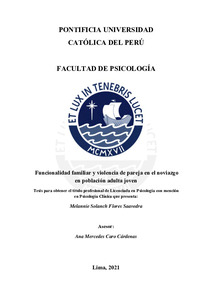| dc.contributor.advisor | Caro Cárdenas, Ana Mercedes | |
| dc.contributor.author | Flores Saavedra, Melannie Solanch | |
| dc.date.accessioned | 2022-02-17T21:51:00Z | |
| dc.date.available | 2022-02-17T21:51:00Z | |
| dc.date.created | 2021 | |
| dc.date.issued | 2022-02-17 | |
| dc.identifier.uri | http://hdl.handle.net/20.500.12404/21664 | |
| dc.description.abstract | La familia busca lograr el desarrollo humano positivo a nivel físico, social y
emocional de sus miembros (Rodríguez, Herrera, Lorenzo & Alvarez, 2008). Para
alcanzar este desarrollo se debe mantener un funcionamiento familiar sano, ya que un mal
funcionamiento familiar desarrolla emociones morales poco adaptativas generando
comportamientos disruptivos como lo es la agresividad. Se conoce que en el país se
presentan altos índices de violencia en las familias y parejas, ya que cuando estas tienen
algún conflicto se resuelven, en su mayoría, con agresiones físicas, sexuales y/o
psicológicas (Gracia-Leiva, Puente-Martínez, Ubillos-Landa, & Páez-Rovira, 2019). Por
tal motivo, la presente investigación tuvo como objetivo analizar la relación entre el
funcionamiento familiar y la violencia de pareja en el noviazgo en población adulta joven.
Para este fin se contó con la participación de 68 jóvenes de Lima cuyos rangos de edad
oscilaban entre los 18 y 33 años (M= 24,04). Los instrumentos utilizados fueron el
FACES IV que mide el funcionamiento familiar por Olson (2010) y la adaptación
Mexicana del M-CTS realizada por Ronzón-Tirado, Muñoz-Rivas, Zamarrón Cassinello
y Redondo Rodríguez (2019), el cual mide las expresiones de violencia en el noviazgo
tales como argumentación, violencia psicológica, violencia física leve y violencia física
grave. Como resultado, se encontró que la agresión psicológica en víctimas presenta
correlaciones inversas y bajas con la escala de cohesión familiar; asimismo, la escala de
agresión física moderada hacia las víctimas presenta correlaciones directas y bajas con la
escala de desunión y la escala caótica del FACES IV. | es_ES |
| dc.description.abstract | The family seeks to achieve positive human development at the physical, social,
and emotional levels of its members (Rodríguez, Herrera, Lorenzo & Alvarez, 2008). To
achieve this development, a healthy family functioning must be maintained; otherwise, a
dysfunctional family develops moral emotions that are not very adaptive, generating
disruptive behaviors such as aggressiveness. It is known that there are high rates of
violence in families and couples in the country, for example, when they have a conflict
those are resolved, regularly with physical, sexual, and/or psychological aggression
(Gracia-Leiva, Puente-Martínez, Ubillos-Landa, & Páez-Rovira, 2019). For that reason,
the present investigation aims to analyse the relationship between the variable family
functioning and dating violence of young adult people. The study was conducted with a
sample of 68 young people belonging to a private university in Lima whose age ranges
between 18 and 33 years (M= 24,04). The instruments used were FACES IV which
measures family functioning and has been culturally adapted to Spanish by Olson (2010)
and, M-CTS, adapted in Mexico by Ronzón-Tirado, Muñoz-Rivas, Zamarrón Cassinello
and Redondo Rodríguez (2019), to measure expressions of violence such as
argumentation, psychological violence, mild physical violence and serious physical
violence. Overall, the scale of victims’ psychological aggression shows inverse and low
correlations with the cohesion scale; likewise, the average scale of physical aggression
victims presents direct and low correlations with the disengaged scale and the chaotic
scale. | es_ES |
| dc.language.iso | spa | es_ES |
| dc.publisher | Pontificia Universidad Católica del Perú | es_ES |
| dc.rights | info:eu-repo/semantics/openAccess | es_ES |
| dc.rights.uri | http://creativecommons.org/licenses/by/2.5/pe/ | * |
| dc.subject | Violencia en el noviazgo | es_ES |
| dc.subject | Violencia familiar | es_ES |
| dc.subject | Relaciones de pareja | es_ES |
| dc.subject | Familia--Aspectos psicológicos | es_ES |
| dc.title | Funcionalidad familiar y violencia de pareja en el noviazgo en población adulta joven | es_ES |
| dc.type | info:eu-repo/semantics/bachelorThesis | es_ES |
| thesis.degree.name | Licenciado en Psicología con mención en Psicología Clínica | es_ES |
| thesis.degree.level | Título Profesional | es_ES |
| thesis.degree.grantor | Pontificia Universidad Católica del Perú. Facultad de Psicología | es_ES |
| thesis.degree.discipline | Psicología con mención en Psicología Clínica | es_ES |
| renati.advisor.dni | 06477579 | |
| renati.advisor.orcid | https://orcid.org/0000-0001-9983-0685 | es_ES |
| renati.author.dni | 48447117 | |
| renati.discipline | 313026 | es_ES |
| renati.juror | Távara Vásquez, María Gabriela | es_ES |
| renati.juror | Caro Cárdenas, Ana Mercedes | es_ES |
| renati.juror | Fernández Godenzi, Adriana Isabel | es_ES |
| renati.level | https://purl.org/pe-repo/renati/level#tituloProfesional | es_ES |
| renati.type | https://purl.org/pe-repo/renati/type#tesis | es_ES |
| dc.publisher.country | PE | es_ES |
| dc.subject.ocde | https://purl.org/pe-repo/ocde/ford#5.01.00 | es_ES |






